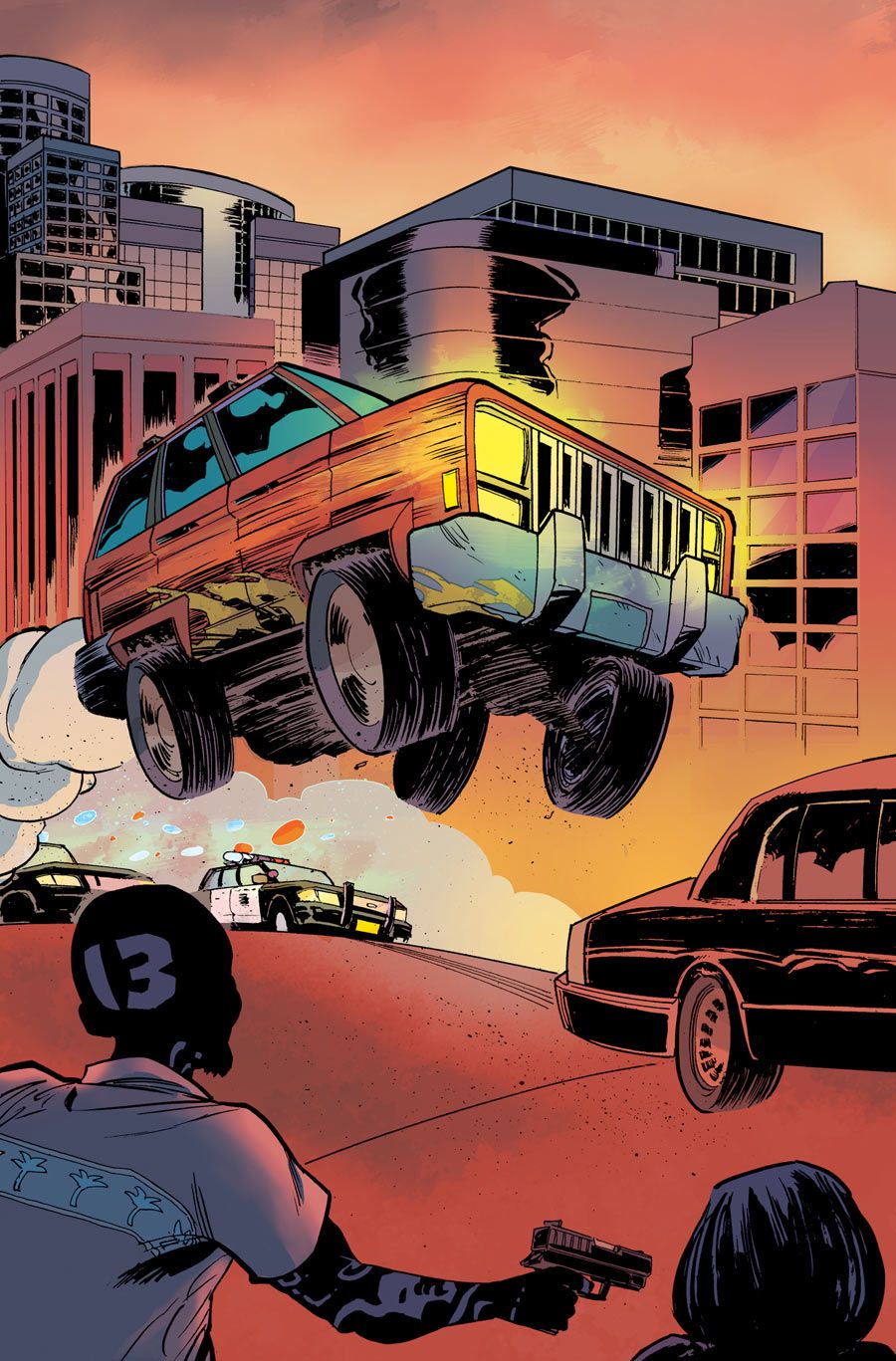In "Stringers" #1 by Marc Guggenheim and Justin Greenwood, a wall of dialogue greets the reader on the first page. Guggenheim's daring opening gambit deviates from the usual opening page playbook by demanding that the reader slow down to read a lot of words right past the entrance. The onslaught of text and the manic back-and-forth patter of conversation succeed in grabbing the reader's attention, and they also advertise an urban atmosphere and irreverent humor. Even better, Guggenheim gets into some compressed characterization right away. Even a casual glance at the conversation reveals that Nick and Paul are friends, and that they've been work partners for so long that they bicker like an old married couple.
Some of the plot elements are well-worn, like Paul keeping his career change plans a secret from his partner, but Guggenheim uses the trope to telegraph the differences between the two friends. On the first page, what separates the two characters is how Nick is much more prone to hyperbole. Guggenheim takes this sliver of difference and pries it farther and farther open with each page, until the two men are foils to each other. At the end of the first issue, a classic dynamic has been established: Paul's good sense and self-preservation make him the straight man to Nick's antics and true-believer idealism. The dialogue is sharp enough to offset the familiarity of the double act. Nailing the character introductions is always a good start any story, but it's critical for a miniseries.
Guggenheim hogs the stage and showboats far more than Greenwood. This is unexpected and notable because "Stringers" #1 is a comic in which car chases take up more than half the action. The imbalance is somewhat of a pity, because Greenwood's art has wonderful flow. The linework on his cars is beautiful and his transitions are graceful. He conveys a lot of facts without confusion, and he knows how to keep a firm hold on the reader's visual interest without resorting to over-dramatic perspective angles. This isn't to say that Guggenheim is a bad dance partner. None of his text is redundant and he trusts Greenwood to handle important moves. It's just that Guggenheim's narrative style shouts "look at me!" more than Greenwood's quiet excellence, which is dampened and flattened by Ryan Hill's minimalist color palette.
The most obvious example of verbal emphasis over visual prominence is the sound effects. Traditionally, written sound effects are an accent to action and an attempt to give comics an audio component. Onomatopoeic sound effects are classic, but long-time comics readers who see a "WHOOSH" or "POW" are more likely to respond with a fond smile rather than feeling a tightening of plot tension. In other words, "Ka-BOOM" has been domesticized. Like dead metaphors that have lost their figurative qualities, onomatopoeic sound effects are so overused that they don't get a big visceral response anymore.
That being said, the sound effects in "Stringers" #1 are not onomatopoeic but descriptive. "AndTheWindowsAreNotBulletproof" conveys information over sound, although the occasion is still an aural event. Again, Guggenheim takes a risk. It requires more engagement from the reader to take in the squished writing with no spaces. Deciphering the sound effect text takes only seconds, but it's still a lot longer than the time it takes to read and register an onomatopoeic word. Onomatopoeic sound effects are standard for a reason; they most closely approximate the experience of hearing real noises. Guggenheim demands more from the reader.
The descriptive sound effects are funny, and the ironic, light humor fits in well with Guggenheim's other jokes. It wouldn't be right for every story and I can see it quickly getting old, but it creates a gritty-yet-light-hearted atmosphere in a gunfight, which is no small feat. I'll also give it to Guggenheim that, during "Stringers" #1, there's pleasure in the novelty.
The action drags halfway through, but -- just when the reader is wondering if anything else is going to occur besides fending off rival stringer Tom "Sleaze" Speeziali -- Nick decides to get out of the car. The plot tension spikes, and Greenwood's panel compositions for this shift in pacing are superb all the way to the ending sequence that introduces a mystery and higher stakes. "Stringers" #1 is a solid debut, and I look forward to seeing if it keeps its mix of humor and high speed in later issues.

